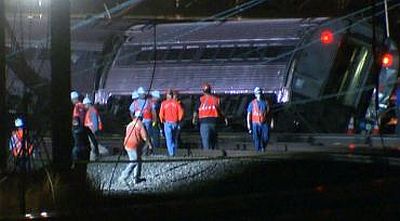Ellen Brown – The dangerous underfunding of US infrastructure was underscored by a fatal train derailment on May 12th. The tragedy did not deter the House Appropriations Committee from voting to slash Amtrak funding the very next day. There are ways Congress could fund its massive infrastructure bill without raising taxes. But the conservative-controlled Congress seems to have other plans for the nation’s profitable public assets.
 The May 12th train derailment near Philadelphia, which killed eight people and hospitalized 200, was the deadliest Amtrak accident in recent history. The train barreled around a dangerous bend at 106 mph, more than double the 50 mph speed limit for the curve.
The May 12th train derailment near Philadelphia, which killed eight people and hospitalized 200, was the deadliest Amtrak accident in recent history. The train barreled around a dangerous bend at 106 mph, more than double the 50 mph speed limit for the curve.
Whether this was due to operator error or mechanical issues is not yet known. But experts say the derailment might have been averted by a safety system called positive train control, which can automatically reduce the speed of a train that is going too fast. The system must be installed on both the train and the route. The Amtrak train had it, but on that stretch of track in that direction it was not yet operational.
Why not? The stretch was known to be dangerous. Nearly 80 passengers died near the spot in an earlier derailment in 1943. Absence of positive train control was also cited as a factor in the fatal 2013 crash of a Metro-North train in the Bronx.
The chief problem, as with infrastructure generally, is a woeful lack of funds. Railroads are under a congressional mandate to install the positive train control system on passenger routes and major freight lines by the end of the year, but they are seeking an extension because of the cost and complexity of the work.
In an article titled “Why You Can’t Talk About the Amtrak Derailment Without Talking About Our Infrastructure Crisis,” Aviva Shen observes that the Northeast Corridor is the busiest and most profitable rail route in the US. The line, which runs from Boston through New York City, Philadelphia, and Baltimore to Washington D.C. , is dealing with more riders now than ever. But Amtrak has been starved of the funds required to keep up with this increased demand. It faces a backlog of repairs on bridges and tunnels that date back to the beginning of the 20th century, obsolete rail interlockings, and trains that rely on 1930s-era components. Repairs for the Northeast Corridor are expected to require $4.3 billion in fiscal years 2015-2019, while federal funding is expected to dwindle to $872 million. Continue reading
